Related Research Articles
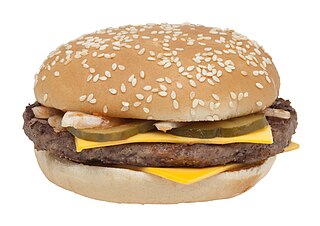
A hamburger, or better known as a burger, is a food consisting of fillings—usually a patty of ground meat, typically beef—placed inside a sliced bun or bread roll. Hamburgers are often served with cheese, lettuce, tomato, onion, pickles, bacon, or chilis; condiments such as ketchup, mustard, mayonnaise, relish, or a "special sauce", often a variation of Thousand Island dressing; and are frequently placed on sesame seed buns. A hamburger patty topped with cheese is called a cheeseburger.

A fast-food restaurant, also known as a quick-service restaurant (QSR) within the industry, is a specific type of restaurant that serves fast-food cuisine and has minimal table service. The food served in fast-food restaurants is typically part of a "meat-sweet diet", offered from a limited menu, cooked in bulk in advance and kept hot, finished and packaged to order, and usually available for take away, though seating may be provided. Fast-food restaurants are typically part of a restaurant chain or franchise operation that provides standardized ingredients and/or partially prepared foods and supplies to each restaurant through controlled supply channels. The term "fast food" was recognized in a dictionary by Merriam–Webster in 1951.

A greasy spoon is a small, cheap restaurant typically specializing in fried foods. The term greasy spoon has been used in the United States since at least the 1920s to describe diners and coffee shops, and is presently used throughout the United Kingdom and the Republic of Ireland to refer to British and Irish cafes. According to the Oxford English Dictionary, the term greasy spoon originated in the United States and is now used in various English-speaking countries.

A diner is a type of restaurant found across the United States and Canada, as well as parts of Western Europe. Diners offer a wide range of foods, mostly American cuisine, a casual atmosphere, and, characteristically, a combination of booths served by a waitstaff and a long sit-down counter with direct service, in the smallest simply by a cook. Many diners have extended hours, and some along highways and areas with significant shift work stay open for 24 hours.

In a restaurant, the menu is a list of food and beverages offered to customers and the prices. A menu may be à la carte – which presents a list of options from which customers choose – or table d'hôte, in which case a pre-established sequence of courses is offered. Menus may be printed on paper sheets provided to the diners, put on a large poster or display board inside the establishment, displayed outside the restaurant, or put on a digital screen. Since the late 1990s, some restaurants have put their menus online.

A Dagwood sandwich is a tall, multilayered sandwich made with a variety of meats, cheeses, and condiments. It is named after Dagwood Bumstead, a central character in the comic strip Blondie, who is frequently illustrated making enormous sandwiches. According to Blondie scripter Dean Young, his father, Chic Young, began drawing the huge sandwiches in the comic strip in 1936.

Denny's Corporation is an American table service diner-style restaurant chain. It operates over 1,700 restaurants in many countries.
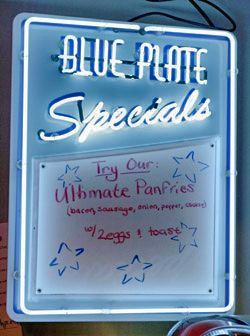
A blue-plate special is a discount-priced meal that usually changes daily: a term used in the United States and Canada by restaurants, especially diners and cafes.

Placeholder names are intentionally overly generic and ambiguous terms referring to things, places, or people, the names of which or of whom do not actually exist; are temporarily forgotten, or are unimportant; or in order to avoid stigmatization, or because they are unknowable and/or unpredictable given the context of their discussion; to de-emphasize in which event the precise specification thereof is otherwise impossible, or to deliberately expunge.

A theme restaurant is a type of restaurant that uses theming to attract diners by creating a memorable experience. Theme restaurants have a unifying or dominant subject or concept, and utilize architecture, decor, special effects, and other techniques, often to create exotic environments that are not normally associated with dining because they are inaccessible, no longer exist, are fictional or supernatural, or taboo. The theme may be further extended through the naming and choices of food, though food is usually secondary to entertaining guests.
William J. Obanhein, also known as Officer Obie, was the chief of police for the town of Stockbridge, Massachusetts. He was a member of the police force there for 34 years, 1951 to 1985. He is fairly well known for his appearances in popular culture.

A tavern sandwich is a sandwich consisting of ground beef on a bun, sometimes mixed with sauteed onions, and sometimes topped with pickles, ketchup, mustard, raw onions, and/or cheese.

A lunch counter or luncheonette is a small restaurant, similar to a diner, where the patron sits on a stool on one side of the counter and the server serves food from the opposite side of the counter, where the kitchen or food preparation area is located. As the name suggests, they were primarily used for the lunch meal. Lunch counters were once commonly located inside variety stores, pharmacies, and department stores in the United States throughout the 20th century. The intent of the lunch counter in a store was to profit from serving hungry shoppers, and to attract people to the store so that they might buy merchandise.
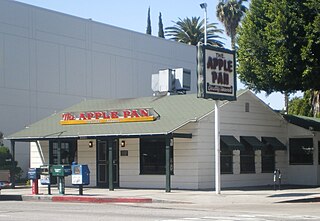
The Apple Pan is a restaurant in Los Angeles, opened in 1947, that is locally famous for its hamburgers, apple pies served with vanilla ice cream, and banana cream pie.
Restaurants fall into several industry classifications, based upon menu style, preparation methods and pricing, as well as the means by which the food is served to the customer. This article mainly describes the situation in the US, while categorisation differs widely around the world.

A food court is generally an indoor plaza or common area within a facility that is contiguous with the counters of multiple food vendors and provides a common area for self-serve dinner. It can also be a public dining area in front of a cafe or diner.
Joe's Diner may refer to
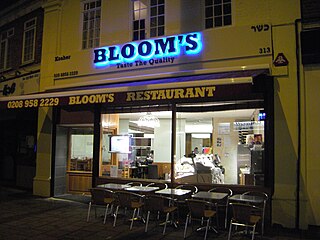
A kosher restaurant or kosher deli is an establishment that serves food that complies with Jewish dietary laws (kashrut). These businesses, which also include diners, cafés, pizzerias, fast food, and cafeterias, and are frequently in listings together with kosher bakeries, butchers, caterers, and other similar places, differ from kosher-style businesses in that they operate under rabbinical supervision, which requires the observance of the laws of kashrut, as well as certain other Jewish laws, including the separation of meat and dairy.
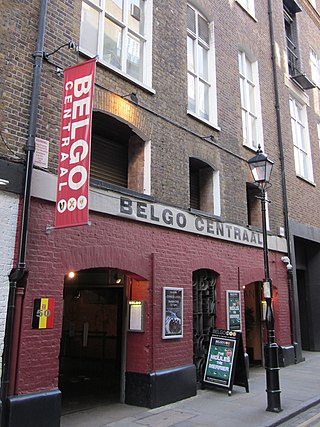
Belgo was a chain of London restaurants specializing in simple Belgian cooking and Belgian beer. There were five Belgo restaurants: Belgo Centraal, Belgo Holborn, Belgo Kings Cross, Belgo Nottingham and Belgo Bromley ; following closures announced in July 2020.
References
- ↑ Barry M. Levenson, Habeas Codfish: Reflections on Food and the Law (2001), p. 116.
- ↑ Larry Cultrera, Classic Diners of Massachusetts (2011), p. 112.
- ↑ The New Yorker (2001), Volume 77, Issues 1-9, p. 97.
- ↑ See, for example, What's Good at Trader Joe's?: Joe's Diner Mac n' Cheese (August 17, 2010).
- ↑ Singin' in the Rain (1952), t. 1:17:02